The UV-C LED market is estimated to be valued at USD 1205.1 million in 2025 and is projected to reach USD 18774.5 million by 2035, registering a compound annual growth rate (CAGR) of 31.6% over the forecast period.
The UV-C LED market is projected to expand from USD 1,205.1 million in 2025 to USD 18,774.5 million by 2035, reflecting a staggering 31.6% CAGR and generating an absolute dollar opportunity of USD 17,569.4 million. Growth is driven by rising demand for effective disinfection solutions in healthcare, water treatment, air purification, and food processing. UV-C LEDs provide energy-efficient, mercury-free, and compact alternatives to traditional UV lamps, enabling integration into consumer, commercial, and industrial applications.
Technological advancements, including higher output power, longer lifespans, and smart system integration, further accelerate market adoption globally. Year-on-year (YoY) growth analysis illustrates the dynamic expansion pattern over the forecast period. In the early years, from 2025 to 2027, YoY growth is extremely high, reflecting rapid adoption in healthcare, water purification, and surface disinfection systems as regulatory emphasis on pathogen control strengthens.
Between 2028 and 2031, YoY growth remains robust but slightly moderates as early adoption saturates mature markets like North America and Europe, while emerging markets in Asia Pacific and Latin America gain momentum. From 2032 to 2035, YoY growth stabilizes at a high level, fueled by widespread integration in HVAC systems, industrial applications, and consumer products, as well as continuous technology improvements. The YoY analysis confirms a high-velocity growth trajectory, underscoring the transformative adoption of UV-C LED technology across diverse sectors and regions.
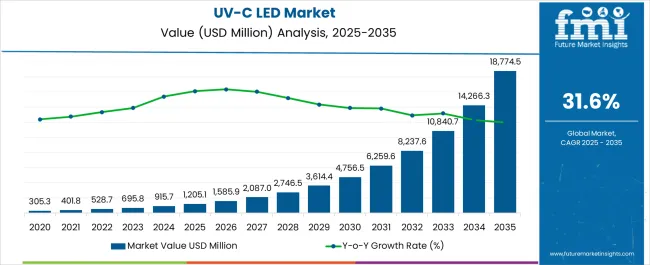
| Metric | Value |
|---|---|
| UV-C LED Market Estimated Value in (2025 E) | USD 1205.1 million |
| UV-C LED Market Forecast Value in (2035 F) | USD 18774.5 million |
| Forecast CAGR (2025 to 2035) | 31.6% |
The UV-C LED market is driven by five primary parent markets with specific shares. Water and wastewater treatment lead with 35%, using UV-C LEDs for disinfection and pathogen control. Healthcare and medical devices contribute 25%, employing LEDs for sterilization of instruments and surfaces. Air purification accounts for 15%, integrating UV-C LEDs into HVAC systems and air cleaners. Food and beverage processing represent 15%, utilizing UV-C LEDs to ensure microbial safety and extend shelf life. Consumer electronics and household appliances hold 10%, incorporating UV-C LEDs in portable sanitizers and sterilizers. These segments collectively define global demand for UV-C LED technologies.
Recent developments in the UV-C LED market focus on efficiency, miniaturization, and integration. Manufacturers are enhancing LED output, lifetime, and energy efficiency to expand application scope. Innovations include compact and portable sterilization devices, water purification systems, and smart air purifiers. Integration with IoT and automation enables remote monitoring, real-time performance tracking, and predictive maintenance. Growing emphasis on hygiene, stricter sanitation standards, and adoption in healthcare, food, and consumer sectors are driving market growth. These trends are accelerating technological advancement, broadening applications, and promoting the adoption of UV-C LED solutions worldwide.
The UV-C LED market is expanding rapidly, driven by the increasing adoption of advanced disinfection technologies in residential, commercial, and industrial settings. The ability of UV-C LEDs to provide chemical-free, energy-efficient sterilization has accelerated their uptake in water treatment, air purification, and surface disinfection systems.
The current market environment is shaped by heightened hygiene awareness, stricter health regulations, and the miniaturization of LED modules enabling integration into compact consumer devices. Manufacturers are investing in improving wavelength efficiency, extending operational lifespans, and reducing costs to increase market penetration.
Demand is further supported by the growth of decentralized water purification systems and the use of UV-C LEDs in healthcare and public infrastructure. With environmental regulations favoring mercury-free solutions, UV-C LED technology is positioned to replace traditional disinfection methods, offering strong long-term growth prospects.
The market is segmented by power output, application, end-user industry, and region. By power output, the market is categorized into 1 mW to 10 mW, 11 mW to 100 mW, and more than 100 mW. Based on application, the market is divided into water disinfection, surface disinfection, air disinfection, and others. In terms of end-user industry, the market is segmented into residentional, commercial, and industrial. Regionally, the market is classified into North America, Latin America, Western Europe, Eastern Europe, East Asia, South Asia & Pacific, and the Middle East & Africa.
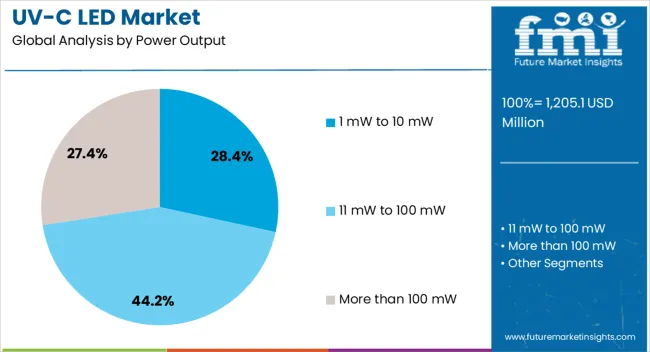
The 1 mW to 10 mW segment holds approximately 28.4% share in the power output category, supported by its suitability for compact disinfection devices and small-scale sterilization systems. This range balances energy consumption and effectiveness, making it ideal for portable water purifiers, consumer appliances, and personal hygiene products.
The segment benefits from lower production costs compared to higher-output LEDs, enabling broader accessibility in consumer markets. Technological advances have improved light uniformity and thermal management, enhancing product reliability.
With growing integration into everyday household and commercial devices, this segment is expected to maintain its share as demand for convenient, point-of-use disinfection solutions continues to rise.
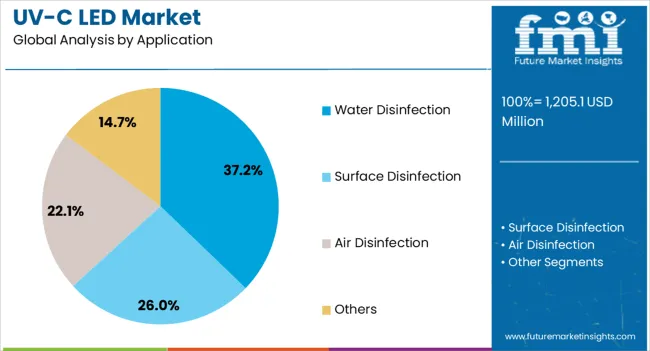
The water disinfection segment leads the application category with approximately 37.2% share, reflecting its central role in driving UV-C LED adoption. The segment benefits from increasing demand for safe, chemical-free drinking water solutions in both urban and rural areas.
UV-C LEDs provide rapid pathogen inactivation without altering taste or introducing harmful by-products, making them an attractive alternative to conventional chlorination. Compact form factors allow integration into residential water filters, portable purifiers, and decentralized treatment units.
Regulatory pressure to ensure clean water access, coupled with growing public awareness of waterborne diseases, is further boosting adoption. The segment’s growth trajectory is reinforced by rising investments in water infrastructure modernization across developing economies.

The commercial segment accounts for approximately 50.9% share in the end-user industry category, driven by the integration of UV-C LEDs into large-scale disinfection systems across offices, retail spaces, hospitality, healthcare facilities, and public infrastructure. Increasing demand for enhanced hygiene standards and continuous air and surface sterilization has accelerated uptake in high-traffic commercial environments.
Manufacturers are responding by developing UV-C enabled HVAC systems, escalator handrail sterilizers, robotic cleaning units, and water purification systems tailored for commercial use. The segment’s growth is further supported by stringent regulatory requirements, corporate investment in workplace safety, and rising adoption of smart building solutions.
As modular and high-output UV-C LED systems become more scalable and energy-efficient, commercial adoption is expected to expand further, solidifying this segment’s position as the dominant end-user category in the market.
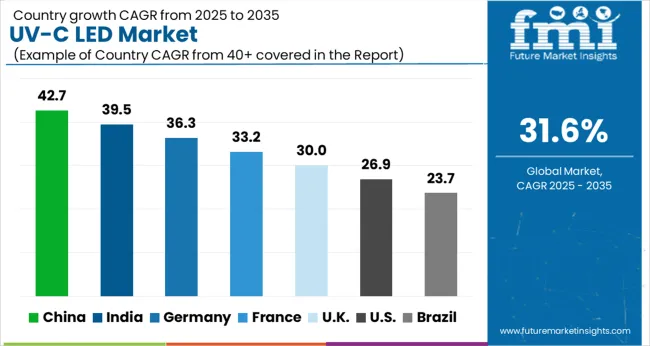
| Country | CAGR |
|---|---|
| China | 42.7% |
| India | 39.5% |
| Germany | 36.3% |
| France | 33.2% |
| U.K. | 30.0% |
| U.S. | 26.9% |
| Brazil | 23.7% |
The UV-C LED market is projected to grow at a global CAGR of 31.6%, driven by rising demand for disinfection, water purification, and medical sterilization applications. China leads at 42.7%, a 1.35× multiple of the global benchmark, fueled by BRICS-led electronics manufacturing, healthcare infrastructure expansion, and technological innovation. India follows at 39.5%, a 1.25× multiple, reflecting growing urban sanitation needs, healthcare sector adoption, and industrial applications. Germany records 36.3%, a 1.15× multiple, shaped by OECD-focused innovation, industrial sterilization, and regulatory compliance. The United Kingdom posts 30.0%, slightly below the global rate, supported by commercial and institutional adoption. The United States stands at 26.9%, 0.85× the benchmark, with demand concentrated in healthcare and industrial sterilization solutions. BRICS countries drive volume growth, OECD markets emphasize technological advancement and compliance, and ASEAN contributes through industrial and healthcare applications. This report includes insights on 40+ countries; the top markets are shown here for reference.
The UV-C LED market in China is projected to grow at a CAGR of 42.7%, driven by rising demand for disinfection solutions across healthcare, water treatment, and food processing industries. Leading suppliers such as Sanan Optoelectronics, HC Semitek, and Seoul Viosys provide high-intensity UV-C LEDs for sterilization, surface disinfection, and air purification applications. Adoption is concentrated in hospitals, water treatment plants, food processing facilities, and public transportation. Technological trends include compact LED modules, high-power UV-C arrays, and integration with IoT-enabled devices for automated disinfection. Government initiatives to control microbial contamination and promote public health reinforce the growth of UV-C LED applications across China.
The UV-C LED market in India is expected to grow at a CAGR of 39.5%, supported by expanding healthcare infrastructure, industrial sterilization, and growing adoption in water treatment and food safety. Suppliers including Sanan Optoelectronics, Seoul Viosys, and local LED manufacturers offer high-efficiency UV-C LEDs with energy-efficient designs and enhanced lifespans. Adoption is concentrated in hospitals, industrial facilities, and municipal water treatment projects. Technological trends include smart integration, high-power arrays, and compact sterilization units. Government programs promoting hygiene, water safety, and disease prevention further strengthen demand for UV-C LEDs in India.
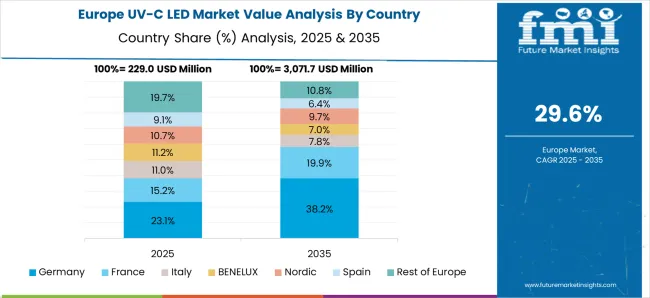
The UV-C LED market in Germany is projected to grow at a CAGR of 36.3%, driven by healthcare, water treatment, and industrial hygiene applications. Leading suppliers such as Osram, Seoul Viosys, and Nichia provide high-performance UV-C LEDs with high irradiance, long lifespan, and energy efficiency. Adoption is concentrated in hospitals, water purification plants, and food processing industries. Technological trends include high-power LED arrays, IoT-enabled disinfection, and automated sterilization systems. Strict hygiene standards, environmental regulations, and strong industrial infrastructure support the adoption of UV-C LED technologies across Germany.
The UV-C LED market in the United Kingdom is expected to grow at a CAGR of 30.0%, supported by healthcare, water treatment, and industrial disinfection applications. Suppliers such as Osram, Nichia, and Seoul Viosys provide energy-efficient and high-intensity UV-C LEDs with compact designs for automated sterilization. Adoption is concentrated in hospitals, food processing units, and municipal water treatment projects. Technological trends include smart sensors, high-power LED arrays, and integration with IoT-based disinfection solutions. Increasing awareness of hygiene standards, public health programs, and industrial sanitation drives adoption of UV-C LED solutions in the UK.
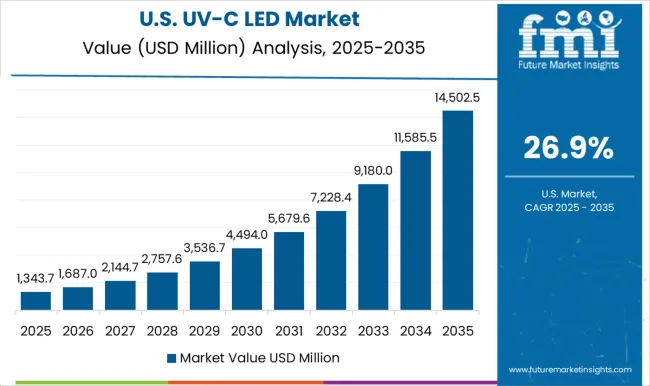
The UV-C LED market in the United States is projected to grow at a CAGR of 26.9%, driven by increasing adoption in healthcare, water treatment, and industrial sterilization. Leading suppliers including Luminus, Seoul Viosys, and Nichia provide high-performance LEDs with long lifespan, energy efficiency, and high-intensity output. Adoption is concentrated in hospitals, food processing facilities, and municipal water treatment projects. Technological trends include high-power arrays, automated disinfection systems, and IoT integration. Federal initiatives promoting public health, water safety, and disease prevention reinforce adoption of UV-C LEDs across industrial and commercial applications in the United States.
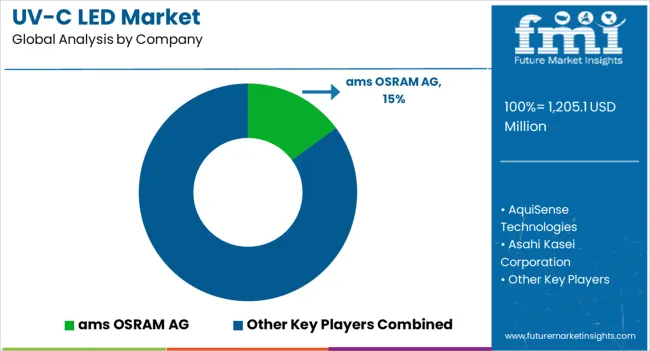
Competition in the UV-C LED market is driven by global semiconductor companies and specialized lighting technology providers, focusing on disinfection efficiency, wavelength precision, and operational lifespan. ams OSRAM AG, LG Innotek, and Luminus Devices, Inc. lead with high-output LEDs for water, air, and surface disinfection, emphasizing energy efficiency and long-term reliability in their brochures. Asahi Kasei Corporation and Dowa Holdings Co., Ltd. target industrial and medical applications, highlighting stable output, thermal management, and safety compliance. AquiSense Technologies, High Power Lighting Corp., and Hönle Group focus on compact, high-intensity solutions suitable for commercial and laboratory environments.
IBT Group (Ivy Bridge Technology), International Light Technologies, and IRTronix, Inc. emphasize customizable configurations, precise wavelength control, and integration flexibility. Brochures detail irradiance levels, operational lifetime, mounting options, and regulatory compliance, enabling buyers to assess performance and suitability for specific applications. Marketing materials shape competitive positioning, combining technical specifications, application guidance, and real-world performance data.
Frequent updates reflect technological improvements, evolving safety standards, and efficiency gains. Larger firms leverage global networks and brand recognition, while smaller companies highlight customization, niche applications, and rapid deployment. Market leadership depends on how effectively brochures communicate UV-C output, reliability, and long-term value in LED disinfection solutions.
| Items | Values |
|---|---|
| Quantitative Units | USD 1205.1 million |
| Power Output | 1 mW to 10 mW, 11 mW to 100 mW, and More than 100 mW |
| Application | Water Disinfection, Surface Disinfection, Air Disinfection, and Others |
| End-user Industry | Residential, Commercial, and Industrial |
| Regions Covered | North America, Europe, Asia-Pacific, Latin America, Middle East & Africa |
| Country Covered | United States, Canada, Germany, France, United Kingdom, China, Japan, India, Brazil, South Africa |
| Key Companies Profiled | ams OSRAM AG, AquiSense Technologies, Asahi Kasei Corporation, Dowa Holdings Co., Ltd., High Power Lighting Corp., Hönle Group, IBT group (Ivy Bridge Technology), International Light Technologies, IRTronix, Inc., and LG Innotek |
| Additional Attributes | Dollar sales by LED type and end use, demand dynamics across water treatment, air purification, healthcare, and surface disinfection, regional trends in germicidal technology adoption, innovation in wavelength efficiency, lifespan, and compact design, environmental impact of production and disposal, and emerging use cases in portable sterilizers and smart sanitation systems. |
The global uv-c led market is estimated to be valued at USD 1,205.1 million in 2025.
The market size for the uv-c led market is projected to reach USD 18,774.5 million by 2035.
The uv-c led market is expected to grow at a 31.6% CAGR between 2025 and 2035.
The key product types in uv-c led market are 1 mw to 10 mw, 11 mw to 100 mw and more than 100 mw.
In terms of application, water disinfection segment to command 37.2% share in the uv-c led market in 2025.






Full Research Suite comprises of:
Market outlook & trends analysis
Interviews & case studies
Strategic recommendations
Vendor profiles & capabilities analysis
5-year forecasts
8 regions and 60+ country-level data splits
Market segment data splits
12 months of continuous data updates
DELIVERED AS:
PDF EXCEL ONLINE
LED and OLED lighting Products and Display Market Size and Share Forecast Outlook 2025 to 2035
LED Digital Speed Limit Sign Market Size and Share Forecast Outlook 2025 to 2035
LED Light Market Size and Share Forecast Outlook 2025 to 2035
LED Loading Dock Light Market Size and Share Forecast Outlook 2025 to 2035
LED Modules and Light Engines Market Size and Share Forecast Outlook 2025 to 2035
LED Control Unit Market Size and Share Forecast Outlook 2025 to 2035
LED Lamp Market Size and Share Forecast Outlook 2025 to 2035
LED Light Tower Market Size and Share Forecast Outlook 2025 to 2035
LED Displays, Lighting and Fixtures Market Size and Share Forecast Outlook 2025 to 2035
LED Tube Market Size and Share Forecast Outlook 2025 to 2035
LED Backlight Driver Market Size and Share Forecast Outlook 2025 to 2035
LEDPackaging Market Size and Share Forecast Outlook 2025 to 2035
LED Neon Lights Market Size and Share Forecast Outlook 2025 to 2035
LED Driver IC Market Analysis - Size, Share, and Forecast Outlook 2025 to 2035
LED Grow Lights Market Analysis by Product, Installation Type, Application and Region Through 2035
LED Backlight Display Driver ICs Market – Growth & Forecast 2025 to 2035
LED Driver for Lighting Market Analysis – Growth & Forecast 2025 to 2035
LED Light Bar Market Analysis - Trends, Growth & Forecast 2025 to 2035
LED Phosphor Material Market
LED Driver Market

Thank you!
You will receive an email from our Business Development Manager. Please be sure to check your SPAM/JUNK folder too.
Chat With
MaRIA